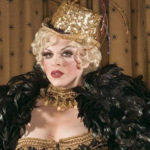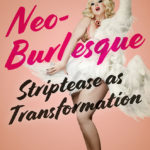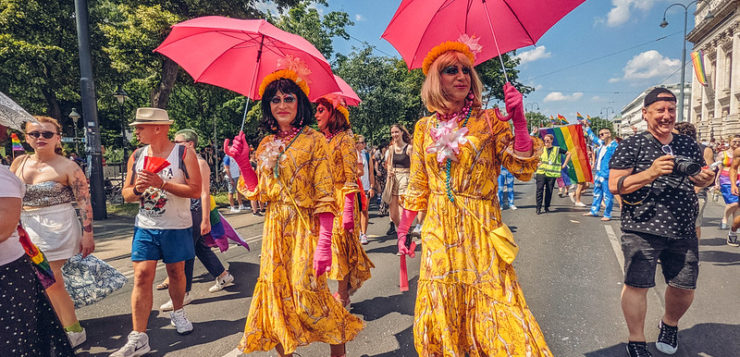
I started identifying as a female drag queen in the early ‘90s. I had seen Paris is Burning (1990) in one of my classes at UC Berkeley and RuPaul was crossing over into the mainstream. Drag queens could even be seen on daytime talk shows, though many, like the Maury Povich Show, likely did more harm than good as they paraded drag queens and transgender people onto stage and invited the audience to shout out “that’s a man” or “that’s a woman.”
And yet there the queens were, on national television, coiffed and dressed to the nines and performing a particular version of femininity that served as inspiration to me. Decades later, I met the World Famous Bob who narrates Jimmy James’ appearance on the Phili Donahue show in 1987 as one of her inspirations, and I discuss this as a kind of “gender becoming” in my forthcoming book, Neo-Burlesque: Striptease as Transformation.
As it turns out, I was not the only person assigned female at birth who had dreams of becoming a drag queen. I was attracted to the excess of drag—the big hair, the extravagant dress and posturing, the almost cartoon-ish makeup, the larger-than-life personas, the unapologetic commitment to excess and camp. After all, Miss Piggy—my first role model—shares many of these same characteristics.
I created a “Drag Box” to store my wigs and costumes. In years later, the box became a closet, then a room, and now, two decades in, drag has taken over the house. In college, I’d open my Drag Box at parties and dress up the boys and girls. I remember getting into drag one night: I wrapped my hair in gold lame and purple fabric as a headdress, put on false eyelashes and dark purple lipstick like the stain of berries, and squeezed into a long-sleeved see-through black shirt with no bra.
My off again/on again boyfriend arrived, took one look at me and proclaimed, “DANG!” And then, “What’s the deal with the getup?”
“I am a female drag queen!” I responded to him and each and every person that night who asked me the exact same question
“You can’t be a drag queen,” he and each and every person that night informed me. “You are a woman.”
***
But there is something significant about this moment, something that deserves telling. For here was a young person looking for inspiration not in unattainable beautify ideals, not in mainstream celebrities, but rather in the margins. I could never be thin like the supermodels that graced the magazine covers, or wealthy and tackily glamorous like the women on Dynasty. This, to me, is the coming out here, the potentially progressive part of this all, that we can emulate the margins rather than the mainstream.
Despite the odds, I moved to New York City and became a drag queen. (While in graduate school in Performance Studies at New York University, I made a video featuring my drag character, “Lady P-Cock,” and after showing it, my classmate turned to me and asked, “Who played the fabulous drag queen in your video?”) Once when taking a cab to a gig, I drove by a group of teenagers on the Lower East Side of Manhattan, and one of them pointed and started yelling, “Look! That’s a man! That’s a man! I am 110% sure that’s a man!” (Lessons learned on Maury.)
I have been asked at clubs if I am a drag queen. At these same clubs I also would hear cis-gender males ask their bro buddies, “Is that a DUDE?” about hyper-feminine women. This was so peculiar to me that women performing in their ultra-feminine glamour and pin-up perfection could get mistaken for impersonators that I started thinking and writing about this as a queering of burlesque spaces.
***
It is not that I want to trick people into thinking I inhabit a subject position that I do not. I also am not advocating putting humans into one of only two gender categories. Instead, what I celebrate in these instances is the commitment to the exaggeration and artifice of gender. Drag is not about emulating normative representations of gender; instead, it is all about spectacular excess. It is about imagining and bringing into being a fabulous “flaming creature,” to invoke Jack Smith’s experimental film of the same title.
Coming out as a female drag queen almost thirty years ago may not seem like a radical act. Having a box of dress-up as an AFAB in the progressive atmosphere of UC Berkeley in the ‘90s was a safe space, and I cannot compare that to the real violence that many face when the same declaration is made by bodies not afforded those privileges. A girl putting on a pair of eyelashes and prancing around without a bra on at a college party is not necessarily subversive. But on the flip side, a young woman finding inspiration in drag was not the norm at that time.
What drag queens taught me was to dress up and flaunt, rather than shrink and apologize. In a culture that continues to devalue women’s contributions, as well as their abilities, this is significant. Though some argue that drag is offensive to women, I find inspiration in its spectacular excess. Besides, drag is not reducible to gender per se but rather it is about expansive imagination, a place to play with images and ideas, textures and colors, flamboyant excess. It is a place to expand beyond, not be reduced to, binaries. It is about pushing boundaries, not staying contained. For what I was doing at that time was finding my inspirations from those who decided to go against the grain of mainstream culture, who lived in the margins, and who wanted to imagine another way of being that may not line up with explicitly with what they were given at birth. For me, claiming that was an act of resistance, a coming out against binary gender roles.
 Lynn Sally is a writer, artist, and scholar of popular culture. Her book, Neo-Burlesque: Striptease as
Lynn Sally is a writer, artist, and scholar of popular culture. Her book, Neo-Burlesque: Striptease as Transformation, is published by Rutgers University Press. https://linktr.ee/LynnS
Transformation, is published by Rutgers University Press. https://linktr.ee/LynnS






